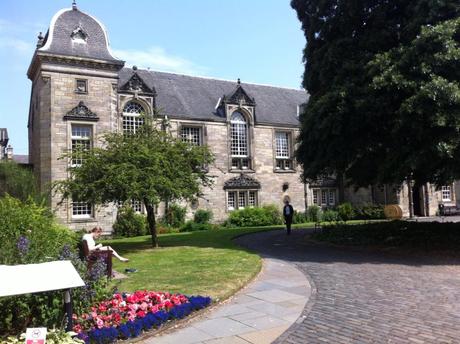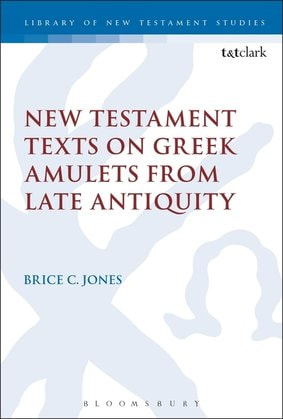 St. Mary's College, St. Andrews St. Mary's College, St. Andrews I arrived in Montreal yesterday afternoon after a weeklong trip in St. Andrews, Scotland for the International Society of Biblical Literature. As mentioned in a previous post, I was scheduled to give two papers in the textual criticism session. Both papers were very well received. My paper on amulets from Oxyrhynchus prompted others to ask why these amulets have been ignored for so long. I think I was successful in demonstrating why amulets and other non-continuous manuscripts of the New Testament merit more attention. My paper on three Coptic New Testament manuscripts that I discovered in the last year generated discussion about Coptic palaeography and dating. Hans Förster and myself together tackled the question concerning the problems of dating, a very problematic affair within the discipline of Coptology. This was my first International SBL to attend as well as my first visit to Europe and it was enjoyable all around. I was also very pleased to have received two publishing invitations. So, many thanks to Tommy Wasserman and Jan Krans for accepting my papers into their fine session and giving me this wonderful opportunity. It was an experience I shall never forget. There were several interesting papers in the textual criticism sessions. Bill Warren gave a paper on P4 (Paris, Bibliothèque Nationale Suppl. grec 1120) and he showed us some recent high-resolution images of the manuscript, the quality of which was superb. These fine images illustrated clearly just how careful the scribe executed his letters. P4 is a beautiful specimen indeed. He gave a discussion of the date and textual character of the papyrus and suggested some improvements to the existing transcript. Matthew Solomon gave a very interesting paper on the water-damaged portions of MS 33, also known as “Queen of the Cursives.” Matthew had recently examined the manuscript in person in the BnF and presented several images that he was allowed to take during his visit. He was able to confirm readings listed in the textual apparatus as “vid” as well as offer revisions to the transcript based on his autopsy. I had suggested that he look into a UV lamp, because if the ink is iron-based the lamp will help tremendously in reading portions of the manuscript where the ink has faded. Jeff Cate's paper on the textual relationship between 792 and 2643, private miniature manuscripts, was great. I was surprised to learn exactly how small these manuscripts actually are. Jeff put the dimensions in context by juxtaposing one of them with his eyeglasses and pencil—they are tiny, barely larger than a deck of cards! What is surprising is how tiny the script is; I believe Jeff said there were over 30 lines per page. Another interesting feature of these manuscripts is their contents: they contain the four Gospels and the Apocalypse, a combination found in only eight other manuscripts. Jan Krans gave an interesting paper on conjectural emendations. He and his team are working on a project where they are tracking conjectural emendations made through the centuries and documenting virtually everything about them. This paper concerned the “confirmation” of a conjectural emendation, that is, the point at which an emendation is “confirmed” when a manuscript containing the reading of an emendation turns up. Square quotes are placed around the word “confirmation” because there is a fundamental question concerning what it actually means when an emendation is “confirmed.” In any case, while conjectural emendation is a tricky business it has always been part of textual criticism so Jan and his team are to be commended for helping us understand its role within the history of the discipline. Jan also gave a demonstration of the software they have developed. Hans Förster gave a fascinating paper relating to his work on the Sahidic manuscripts of John for the Novum Testamentum Graece 28th edition. Förster, along with Siegfried Richter of Münster, has examined the Sahidic manuscripts of John and made suggestions for over 100 improvements in the apparatus of the NA28. These revisions of the attestations of variants were adopted by the committee of the NA28. Förster provided a very interesting discussion about the possible influences of the Coptic tradition on the Greek tradition; the examples he provided were compelling. I think translation phenomena and the relationship between both the Coptic and Greek traditions is under-researched, but Förster, Richter and others are making leaps and bounds. In this regard, Christian Askeland’s new book on the Sahidic translation of the underlying Greek text is the go-to book, which is meritorious. I missed the second textual criticism session because I read my doctoral supervisor’s paper in absentia on altered states of consciousness in the Nag Hammadi corpus but I am sure the papers presented there were also very good. I hope to be able to submit another proposal for the International meeting next year, which will be held in Vienna, Austria. I would not want to miss that congress, because the Österreichische Nationalbibliothek has one of the largest papyrological collections in the world. In any event, this year’s meeting was wonderful and the city of St. Andrews is lovely. I had a nice time reconnecting with old friends and meeting new ones, too. And the local beer and whisky was probably worth the trip in and of itself!
0 Comments
Your comment will be posted after it is approved.
Leave a Reply. |

Available at Amazon!
Archives
June 2020
Categories
All
|